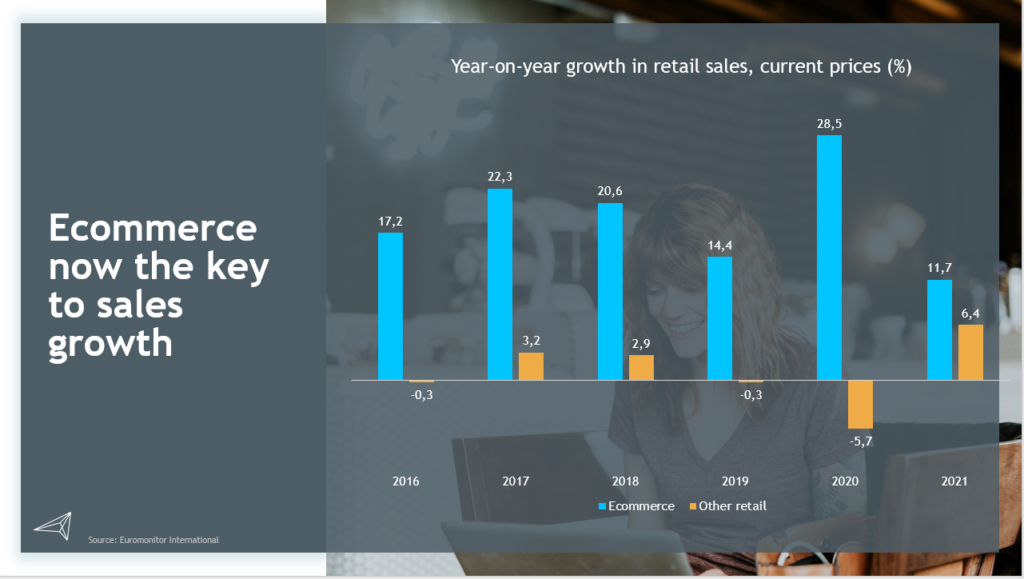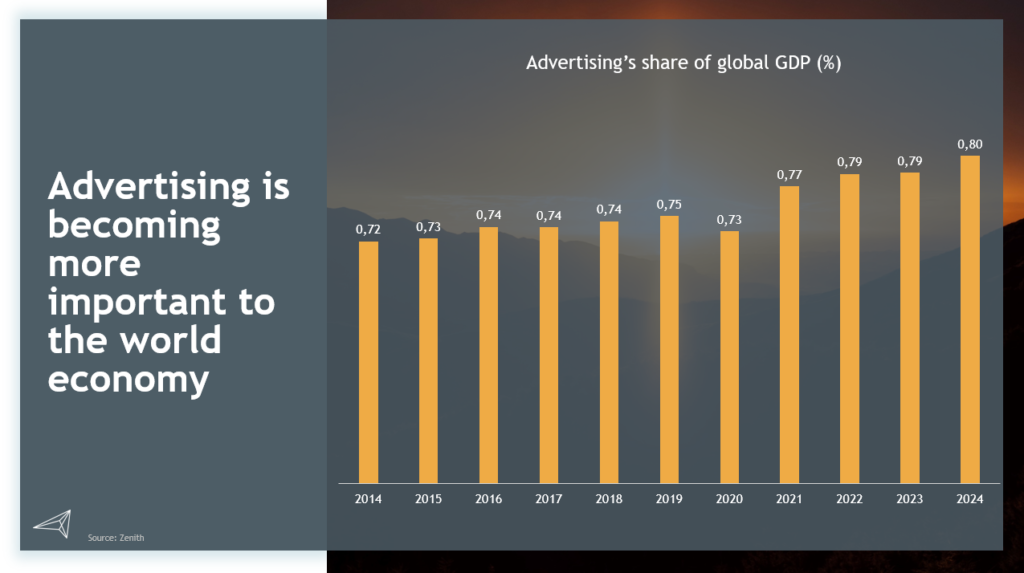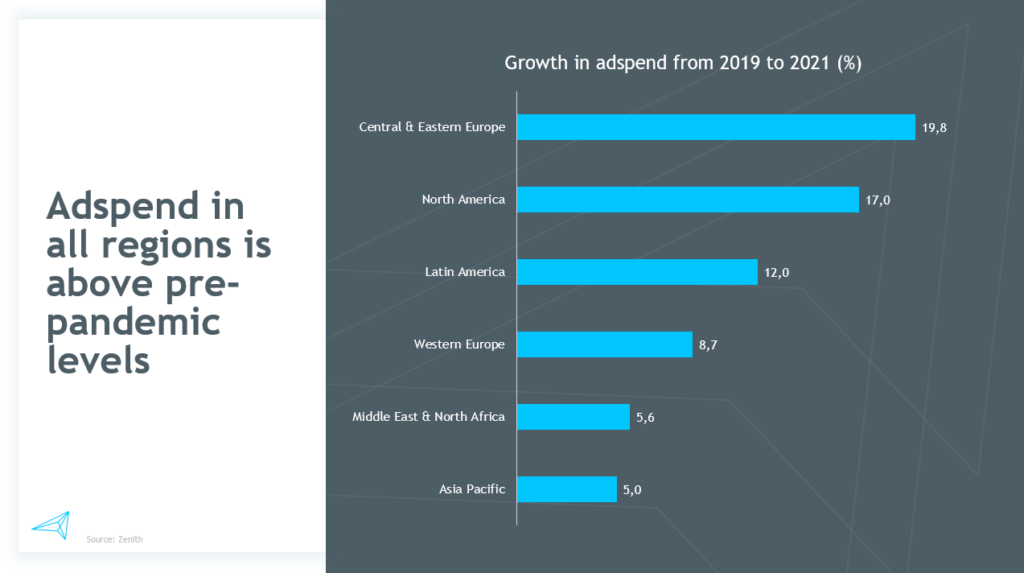- Retailer media advertising to grow from US$77bn this year to US$143bn in 2024
- Social media will lead market with 15% annual growth to 2024
- Online video to grow 14% a year by extending reach and reducing cost of mass-audience brand awareness
The global ad market will continue its remarkable recovery from the 2020 downturn with 9.1% growth in 2022, after 15.6% growth in 2021, according to Zenith’s Advertising Expenditure Forecasts report, published today. Global adspend will expand by 5.7% in 2023 and 7.4% in 2024 as brands continue using advertising to spur further growth in ecommerce.

Zenith estimates that global adspend will reach US$705bn in 2021, up from US$634bn in 2019, and will rise to US$873bn by 2024.
COVID-19 setbacks have extended the period of heightened digital transformation
The pandemic has thoroughly disrupted shopping habits. Many consumers who would prefer to browse and purchase in person are shopping online by necessity. Businesses have responded by invested more than would otherwise have been justifiable in new technology, infrastructure, organisational change – and advertising. This includes brand advertising to promote ecommerce platforms, performance advertising to direct traffic to them, and advertising within these platforms (‘retailer media advertising’) to promote specific products, all of which have surged.
Over the last six months it has become clear that booster shots are necessary to maintain the effectiveness of vaccines, that the fully vaccinated are able to pass on infections quite readily, and that substantial pockets of the population are unwilling to be vaccinated at all. Progress towards containing COVID-19 has been slower than expected, and consumers have been less willing to resume in-person shopping. Businesses have continued their heightened investment in digital transformation, during a period in which many expected to ease back as consumers returned to shops. Digital advertising has therefore been stronger in the second half of this year than previously expected. Zenith now estimates that digital advertising will grow by 25% year-on-year in 2021, compared to the 19% estimated in the previous forecast, published in July.
Zenith expects digital transformation to slow down, but not go into reverse, as the pandemic eases in 2022 and beyond. The pandemic has accelerated trends that were already fundamentally reshaping the economy, and will continue to do so. Zenith forecasts 14% growth in global digital adspend in 2022, up from the previous forecast of 10%, followed by 9% growth in 2023 and 10% in 2024.
Advertising is contributing more to the global economy
This structural change in the economy means that advertising is playing a greater role in driving sales growth through ecommerce. In particular it has sparked a surge in retailer media advertising: display or search advertising that appear on ecommerce platforms.
Retailer media can be highly effective, allowing brands to target active buyers at the point of purchase. Zenith estimates that retailer media advertising surged from 24% growth in 2019 to 53% in 2020, and then 47% in 2021, when it totalled US$77bn. This is equivalent to the sums spent on newspaper, magazine, radio and cinema advertising combined, and accounts for 20% of all expenditure on digital display and paid search advertising. By 2024 retailer media adspend is expected to reach US$143bn, and 27% of display and search. Much of this will be incremental to existing ad expenditure, coming from commercial budgets previously used to negotiate for shelf space in bricks-and-mortar stores.

The rise of the digital economy has also stimulated other forms of advertising, including brand campaigns on television and out-of-home, where digital brands are now prominent. The share of global GDP contributed by advertising had been rising steadily before the pandemic, from 0.72% in 2014 to 0.75% in 2019. After the step-change in digital media consumption and ecommerce last year, it is forecast to reach 0.77% in 2021 and 0.80% by 2024. This will be the biggest rise in advertising’s share of GDP since the late 1990s.

C&E Europe and MENA will grow fastest, but most new ad dollars come from the US
Adspend in all regions is now well above pre-pandemic levels, and all are expected to grow healthily over the next few years. Zenith forecasts the fastest growth between 2021 and 2024 to come from Central & Eastern Europe (C&E Europe) and the Middle East & North Africa (MENA), with average annual growth rates of 12.2% and 10.0% respectively. C&E European advertising is being fuelled by the rise in productivity and disposable incomes as its economies develop towards maturity, encouraging more brands and product categories to enter the market. MENA, meanwhile, is benefiting from high oil prices as demand for energy has outpaced production. The slowest-growth is expected from the mature markets of Western Europe, where growth is forecast at a healthy 5.3% a year.

However, Zenith expects the biggest contribution to the growth in ad dollars to come from the US, where adspend is forecast to expand by US$80bn between 2021 and 2024. That represents 48% of the entire growth in global adspend over this period. The next-largest growth will come from China (US$15.8bn, or 9% of the total), the UK (US$6.0bn, or 4%) and Japan (US$5.4bn, or 3%). These are the world’s four largest ad markets, and make up in scale what they may lack in speed.
Social media is leading ad growth and will overtake television next year
Zenith predicts social media will be the fastest-growing channel between 2021 and 2024, with an average annual growth rate of 14.8%, closely followed by online video at 14.0%. Paid search will grow by 9.8% a year, primarily driven by retailer media, and out-of-home will enjoy solid 7.4% annual growth as foot and vehicle traffic return to normal. Radio and television will grow marginally, by 2.2% and 1.4% respectively, while print declines by 4.7%.
Social media is becoming a more competitive. According to eMarketer, adult social media users in the US are spending 60.4% of their time with Facebook and Instagram this year, down from 74.8% in 2017. That’s the result of the rise of TikTok, which grew from nothing to 15.1% of social media usage over this period. The platforms are also embracing commerce and developing new advanced interactions between brands and consumers. Brands can use self-serve tools to create Augmented Reality experiences and then distribute them through targeted advertising, which can powerfully lift awareness and intent to purchase.
Zenith expects social media adspend to reach US$177bn in 2022, overtaking television at US$174bn. Social media adspend will rise to US$225bn by 2024, when it will account for 26.5% of all advertising, followed by paid search at 22.5% and television at 21.0%.
Digital advertising as a whole will exceed 60% of global adspend for the first time in 2022, reaching 61.5% of total expenditure, and will increase its share to 65.1% by 2024.
Brands need to make smart use of online video to mitigate television inflation
Television advertising remains the easiest route to mass-audience brand awareness, despite years of audience losses to digital media. Brands’ reliance on television is fuelling rapid media inflation, which will continue even after the comparison with 2020 has passed. Zenith forecasts the cost of television advertising to rise by 11% in 2022, compared to 4% for out-of-home, 3% for digital display, 2% for radio and zero for print. Brands will have to confront their dependence on a medium that consistently delivers smaller audiences for higher prices.
Online video is fragmented and complicated to navigate. Multiple platforms deliver content through multiple devices to multiple screens, while ads may be passed through a chain of demand-side platforms, exchanges, ad networks and content delivery networks before reaching the consumer. But, by investing in data and planning technology, and building partnership with providers, brands can use online video to increase their reach and reduce their costs. Zenith forecasts online video adspend to increase from US$62bn in 2021 to US$91bn 2024, when it exceed 50% of this size of television for the first time. Television adspend will rise from US$171bn to US$178bn over the same period.
“As consumers rely ever more on digital technology to connect and entertainment them, and to inspire and fulfil their purchases, advertising is playing a greater role in driving sales and brand growth,” said Jonathan Barnard, Head of Forecasting, Zenith. “Over the next three years we expect the ad market to achieve its highest rate of sustained growth since 2000.”


